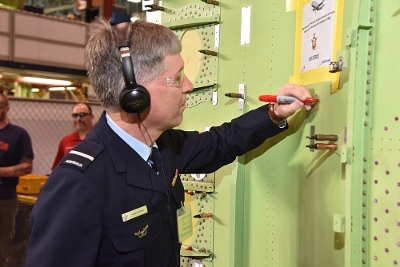
Spirit AeroSystems began production of the fuselage for the first P-8A Poseidon maritime surveillance aircraft for the RAAF last month.
The Kansas-based aerostructures company announced on November 20 that it began production work on the 737 military derivative in October, with the first unit scheduled to be delivered to Boeing early next year.
“Spirit has a unique capability to build military-specific aircraft in the same 737 commercial production line that is producing 42 airplanes a month,” said Duane Hawkins, Spirit senior vice-president of Boeing, defence and regional jet programs.
 The P-8A’s 737-800-based fuselage receives military-specific in-line modifications with Spirit AeroSystems before it is sent to the Boeing final assembly facility in Renton, Washington, a process witnessed during a recent visit by RAAF AIRCDRE Adam Brown, director general Aerospace, Maritime, Training, and Surveillance Branch.
The P-8A’s 737-800-based fuselage receives military-specific in-line modifications with Spirit AeroSystems before it is sent to the Boeing final assembly facility in Renton, Washington, a process witnessed during a recent visit by RAAF AIRCDRE Adam Brown, director general Aerospace, Maritime, Training, and Surveillance Branch.
The Australian government announced approval of the RAAF’s acquisition of eight P-8As with options on a further four in February 2014. The first Australian aircraft is due to be delivered in early 2017 and all eight are expected in service by 2021.
Then Prime Minister Tony Abbott said at the time that acquiring the four optioned aircraft would be considered as part of the new Defence White Paper, which is now due to be released in 2016.
In other P-8 news, the UK Prime Minister David Cameron has announced nine P-8As will be acquired for the Royal Air Force, replacing the service’s anti-submarine warfare capabilities lost with the 2010 cancellation of the Nimrod MRA-4 program.
The P-8 acquisition was a central element of Prime Minister Cameron’s 2015 Strategic Defence and Security Review, which also committed the UK to acquire 135 F-35 Joint Strike Fighters and to upgrade the Eurofighter Typhoon with an AESA radar.
















Mick181
says:I see the RAF have also seen the light on these superb aircraft and are to buy 9 aircraft sometime soon. That will enlarge the overall fleet size and could make future upgrades that bit cheaper.
Chris
says:Given the size of our coastline and the need for training and maintenance I feel the fleet should comprise at least 12 with options for a further 4. No matter how good they are you need sufficient numbers to provide effective security and deterence.
Jason
says:12 P-8s plus >7 MQ-4C Tritons should cover the coastline.
Harry
says:12 P-8s minimum, indeed! 8 P-8s and 7 Tritons to replace 20 PC-3s is insufficient, especially when the P-8s operate at a higher flight level than the PC-3s which are more efficient when closer to the water, where they need to be for good surveillance and ASW operations.
The P-8s will be much more economical and crew efficient, however, but numbers count when your scouring 15%+ of the worlds oceans. The P-8s will also be restricted by weather events when conducting surveillance, but the tritons, while having fuel efficiency can only observe small patches of ocean at any one time. So 12-16 P-8s and 12 tritons is a better mix, especially considering the amount of naval traffic Australia has had to watch out for over the past 15 years. This will only become more burdensome!
Ideally the P-8s should cover not just the coastline but the Western-Indian, of SE Asia including and especially the South China Sea and the much neglected South Pacific which has barely seen any if but a handful of PC-3 flights over the past 15 years!
Jason
says:It’s 25 years since the RAAF operated 20 P-3Cs, the more nominal number since the late 90s AP-3C upgrade has been 15-16, and it’s now down to about 12.
The sensors carried by the Triton and the P-8 are vastly more capable than those in the AP-3C. The P-8’s radar is a generation beyond the Orion’s, and Triton’s radar can cover more than 2m km2 per mission from an altitude of >50,000ft.
The P-8 has faster transit speeds to and from a target and persistence similar to the AP-3C, while Triton can stay aloft for 24 hours or more.
There are also rumours both Triton and P-8 will have high-end ESM systems equivalent to or better than USN EP-3E systems.
I’d say we’ll be better off by a long way with 19 P-8s and Tritons than with 15-16 AP-3Cs.
Harry
says:As much as I admire the work the RAAF have done with 16 AP-3Cs – I am not sure who if anyone doesn’t agree that they should be replaced by the much more effective P-8s, Jason? – I would consider that the AP-3Cs need to be replaced by the P-8s at least one-for-one.
The Way the region to the north has been developing and the coming proliferation of submarines will mean a need to keep an eye on the greater transit of submarines, traffic of naval movements and people smuggling events in addition to the much neglected fisheries protection of the souther seas and the South Pacific. The added tendency to deploy these assets to the Gulf region and the need to exert sovereignty over our waters, with their vast reserves behooves Australia to look at a purchase of a minimum of 12 P-8s and 12 Tritons, but more would be useful.
16 AP-3Cs might have been sufficient when the waters to our north weren’t filled with people smuggling boats, or weren’t crowded like they will become with the coming naval and submarine boom, or when constant deployments outside Australia’s immediate region were a not a rarity but less frequent. However that has changed and will only become more burdensome. Unfortunately so will our ability to afford and crew such assets. Nevertheless. 12 + 12 in my opinion.